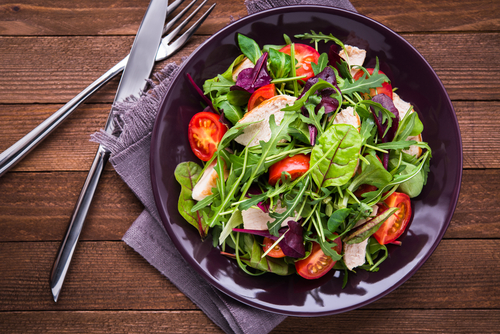The choice of nutritional philosophies is endless these days: We can go vegan; vegetarian; ketogenic; Paleo; flexitarian; pescatarian; Mediterranean; high-fat, low-carb; high-carb, low-fat; raw; and on and on. Trying to find the best one can be overwhelming. I’ve spent many years studying nutrition, and even I have trouble sometimes sifting through all the conflicting science and opinions. For years I tried different diets. I was a vegetarian. Then I went paleo. But eventually, I got fed up. It seems like the world of nutrition is being divided into armed camps, each proclaiming its superiority and decrying the fatal flaws in all the others. The obvious fact is that they all have advantages and disadvantages.
The vegan diet, for example, ideally incorporates plenty of whole, plant-based foods. As a result, vegans get lots of vitamins, minerals, antioxidants, fiber, and healthy fats with none of the baggage that comes with feedlot meat. They’re also making the world a more humane place for the creatures that are treated cruelly by industrial farms, along with reducing their carbon footprint. But even a perfect vegan diet won’t provide enough DHA and EPA, which are important omega-3 fatty acids. Neither will it provide enough iron, zinc, copper, or vitamin D. Vegans are also unlikely to be getting the amount of quality proteins and essential amino acids they require, especially as they age. It’s possible to find sufficient amounts in non-animal sources, but it is incredibly challenging. But they’re definitely not getting B12 because it only comes from animal foods. Finally, it’s entirely possible to be a vegan and still eat a poor diet filled with sugar, refined grains and flour, highly processed oils, soy-based protein substitutes, and foods loaded with chemicals and additives. You can live on Oreos, potato chips, and root beer and still call yourself a strict vegan. Even if you were to swear off wheat and gluten, a common staple in many vegan diets, the food industry is booming with “gluten-free” food items that trick us with misleading health claims on the label. Just because the gluten has been removed from something doesn’t mean it’s healthy; often, it means the exact opposite. If you eat a gluten-free brownie full of gluten-free refined flours and tons of sugar, you’re still wreaking havoc on your blood sugar and weight.
In the last six years, the paleo diet has become the most popular diet among health and wellness advocates. As we all know by now, this regimen is based on the idea that our bodies do best when fueled by foods that existed during the Paleolithic era, before agriculture came along 10,000 or so years ago. That means no sugars (except maybe honey and those occurring naturally in fruit), no grains, no dairy, no legumes or beans, and only nonindustrial meat, fish, whole nonstarchy vegetables, some starchy root vegetables and winter squashes, fruit (but not too much), nuts, and seeds. And that’s about it. As extreme as that may sound, it can be a healthy, low- glycemic diet, especially at a time when so many people are in ill health from eating grain-based sugary foods made with overly processed fats and oils. In fact, emerging research is using this approach, and a more aggressive approach called a ketogenic diet (very-low-carbohydrate, high-fat diet), to reverse type 2 diabetes.
However, some use the paleo philosophy as an excuse to eat too much meat and too few plant-based foods. As critics point out, there were many diets in the paleo era, depending on what part of the world we’re talking about. Back then, humans foraged for their food, mostly plants, and ate animals only when they could find, catch, and kill them. Meat wasn’t nearly as abundant as it is now. Meanwhile, our prehistoric ancestors had a huge amount of healthy plant fiber in their diets (100 to 150 grams a day vs. 8 to 15 grams a day, which is the modern average). Our healthy plant fiber intake doesn’t come anywhere close. I’ve tried both of these diets (vegan and paleo) and plenty of others, but I always wind up finding my way back to a happy medium. A few years ago I was on a panel with two other doctors; one was a paleo advocate and the other a strict vegan cardiologist. I was sitting in the middle, and to lighten things up I joked, “Well, if you’re paleo and you’re vegan, then I must be a pegan.”

